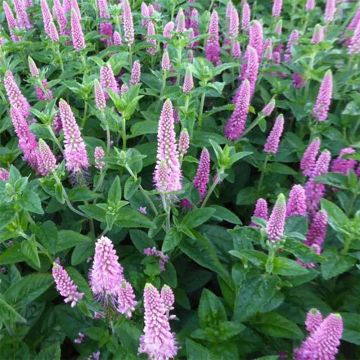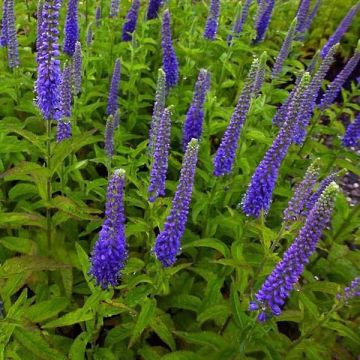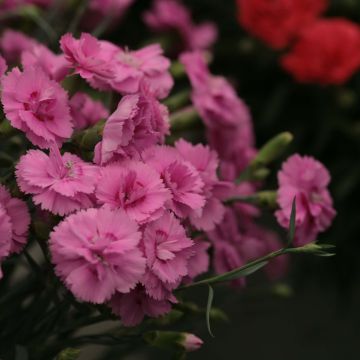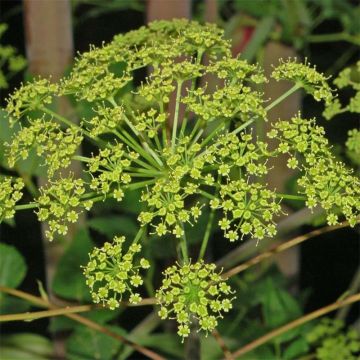

Veronica spicata Erika
Veronica spicata Erika
Veronica spicata Erika
Spiked Speedwell
This item cannot be shipped to the selected country
Delivery charge from €5.90
More information
Schedule delivery date,
and select date in basket
This plant carries a 12 months recovery warranty
More information
We guarantee the quality of our plants for a full growing cycle, and will replace at our expense any plant that fails to recover under normal climatic and planting conditions.
From €5.90 for pickup delivery and €6.90 for home delivery
Express home delivery from €8.90.
Does this plant fit my garden?
Set up your Plantfit profile →
Description
Veronica spicata 'Erika' is a variety of Speedwell that stands out for its compact habit and brightly coloured, long-lasting summer flowering. Its dense spikes packed with tiny vivid pink flowers, rise above abundant dark green foliage. This lovely perennial forms a floriferous mass, covered in butterflies in borders or flower pots. It is very hardy and will grow in any well-drained to dry garden soil, in full sun. Its flowers are perfect for bouquets.
Veronica spicata Erika is from the Plantaginaceae family and is derived from Veronica spicata, or spike speedwell, a perennial plant that mainly grows in mountains up to 2000 metres (6562 feet) in altitude, and occasionally in plains. It can be found in meadows, dry grasslands, rocky slopes and forest edges, mostly on limestone soil.
The 'Erika' variety forms a low, well-branched, floriferous tuft about 30 cm (12in) high and 45 cm (18in) wide. Its leaves can be opposite, but are often whorled in groups of three or four. They are fairly narrow and lanceolate, 6 to 12 cm (2 to 5in) long, with a short petiole, deeply toothed, dark green with a hint of grey. The flowering period extends from June to August, provided that faded flower spikes are regularly removed. The inflorescences are very dense racemes (clusters), resembling compact spikes, tightly packed with tiny, tubular, bright pink flowers with hints of red consisting of four petals and two protruding stamens. The nectar-rich flowers attract numerous pollinating insects.
Veronica Erika is a hardy plant that prefers well-drained, dry soil and will thrive in many regions, including mountain gardens. It goes well with lots of plants and creates beautiful summer compositions in borders, at the front of large beds, in rockeries, and in containers on the terrace. Plant it with Nepetas, Galliums, Heleniums, Astilbe 'Vision in Pink', Filipendula rubra 'Venusta', and Sidalcea, for example. In a wilder style, this perennial forms a very successful combination with shorter grasses like Carex, Festuca, stipa... Its flowers can be used to create beautiful bouquets, with pink or red roses, hydrangeas, ranunculus, asters.
Report an error about the product description
Veronica spicata Erika in pictures






Flowering
Foliage
Plant habit
Botanical data
Veronica
spicata
Erika
Plantaginaceae
Spiked Speedwell
Cultivar or hybrid
Other Veronica - Speedwell
Planting and care
Veronica Erika is an easy-going perennial which prefers dry and well-drained, light, and slightly alkaline (limestone) soil. Heavy soil will reduce its hardiness. It thrives and flowers best in the sun. This little veronica can be planted almost any time of the year, except during periods of frost and summer drought. Trim the faded flower spikes to encourage new flowers. Adding compost at the base of the plant every spring will give it vigour. Avoid using nitrogen-rich fertilisers as they will promote vegetative growth at the expense of flowers. In late winter, cut the plant back to the base and fresh foliage will emerge in spring.
Planting period
Intended location
Care
-
, onOrder confirmed
Reply from on Promesse de fleurs
Summer flowering perennials
Haven't found what you were looking for?
Hardiness is the lowest winter temperature a plant can endure without suffering serious damage or even dying. However, hardiness is affected by location (a sheltered area, such as a patio), protection (winter cover) and soil type (hardiness is improved by well-drained soil).

Photo Sharing Terms & Conditions
In order to encourage gardeners to interact and share their experiences, Promesse de fleurs offers various media enabling content to be uploaded onto its Site - in particular via the ‘Photo sharing’ module.
The User agrees to refrain from:
- Posting any content that is illegal, prejudicial, insulting, racist, inciteful to hatred, revisionist, contrary to public decency, that infringes on privacy or on the privacy rights of third parties, in particular the publicity rights of persons and goods, intellectual property rights, or the right to privacy.
- Submitting content on behalf of a third party;
- Impersonate the identity of a third party and/or publish any personal information about a third party;
In general, the User undertakes to refrain from any unethical behaviour.
All Content (in particular text, comments, files, images, photos, videos, creative works, etc.), which may be subject to property or intellectual property rights, image or other private rights, shall remain the property of the User, subject to the limited rights granted by the terms of the licence granted by Promesse de fleurs as stated below. Users are at liberty to publish or not to publish such Content on the Site, notably via the ‘Photo Sharing’ facility, and accept that this Content shall be made public and freely accessible, notably on the Internet.
Users further acknowledge, undertake to have ,and guarantee that they hold all necessary rights and permissions to publish such material on the Site, in particular with regard to the legislation in force pertaining to any privacy, property, intellectual property, image, or contractual rights, or rights of any other nature. By publishing such Content on the Site, Users acknowledge accepting full liability as publishers of the Content within the meaning of the law, and grant Promesse de fleurs, free of charge, an inclusive, worldwide licence for the said Content for the entire duration of its publication, including all reproduction, representation, up/downloading, displaying, performing, transmission, and storage rights.
Users also grant permission for their name to be linked to the Content and accept that this link may not always be made available.
By engaging in posting material, Users consent to their Content becoming automatically accessible on the Internet, in particular on other sites and/or blogs and/or web pages of the Promesse de fleurs site, including in particular social pages and the Promesse de fleurs catalogue.
Users may secure the removal of entrusted content free of charge by issuing a simple request via our contact form.
The flowering period indicated on our website applies to countries and regions located in USDA zone 8 (France, the United Kingdom, Ireland, the Netherlands, etc.)
It will vary according to where you live:
- In zones 9 to 10 (Italy, Spain, Greece, etc.), flowering will occur about 2 to 4 weeks earlier.
- In zones 6 to 7 (Germany, Poland, Slovenia, and lower mountainous regions), flowering will be delayed by 2 to 3 weeks.
- In zone 5 (Central Europe, Scandinavia), blooming will be delayed by 3 to 5 weeks.
In temperate climates, pruning of spring-flowering shrubs (forsythia, spireas, etc.) should be done just after flowering.
Pruning of summer-flowering shrubs (Indian Lilac, Perovskia, etc.) can be done in winter or spring.
In cold regions as well as with frost-sensitive plants, avoid pruning too early when severe frosts may still occur.
The planting period indicated on our website applies to countries and regions located in USDA zone 8 (France, United Kingdom, Ireland, Netherlands).
It will vary according to where you live:
- In Mediterranean zones (Marseille, Madrid, Milan, etc.), autumn and winter are the best planting periods.
- In continental zones (Strasbourg, Munich, Vienna, etc.), delay planting by 2 to 3 weeks in spring and bring it forward by 2 to 4 weeks in autumn.
- In mountainous regions (the Alps, Pyrenees, Carpathians, etc.), it is best to plant in late spring (May-June) or late summer (August-September).
The harvesting period indicated on our website applies to countries and regions in USDA zone 8 (France, England, Ireland, the Netherlands).
In colder areas (Scandinavia, Poland, Austria...) fruit and vegetable harvests are likely to be delayed by 3-4 weeks.
In warmer areas (Italy, Spain, Greece, etc.), harvesting will probably take place earlier, depending on weather conditions.
The sowing periods indicated on our website apply to countries and regions within USDA Zone 8 (France, UK, Ireland, Netherlands).
In colder areas (Scandinavia, Poland, Austria...), delay any outdoor sowing by 3-4 weeks, or sow under glass.
In warmer climes (Italy, Spain, Greece, etc.), bring outdoor sowing forward by a few weeks.
























































